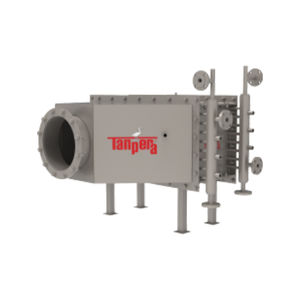
Brazed plate heat exchanger liquid/liquidcompactsmall
Add to favorites
Compare this product
Characteristics
- Type
- brazed plate
- Fluid
- liquid/liquid
- Other characteristics
- compact, small
- Operating pressure
30 bar
(435.11 psi)- Temperature
Max.: 200 °C
(392 °F)Min.: 180 °C
(356 °F)
Description
Construction and mode of operation TANPERA brazed plate heat exchanger consists of: A number of thin, acid-resistant plates, precision stamped and assembled as a unit, each alternate plate being rotated 180º. The plate pack, assembled with two end plates
Construction and mode of operation TANPERA brazed plate heat exchanger consists of: A number of thin, acid-resistant plates, precision stamped and assembled as a unit, each alternate plate being rotated 180º. The plate pack, assembled with two end plates and connections, is vacuum brazed at extremely high temperatures providing a permanently sealed heat exchanger.
Brazed Plate Heat Exchanger Features
The final result is a strong and compact plate heat exchanger with extremely high heat transmissions. The high heat transmission comes from the main pattern which is designed to create a turbulence flow.
Brazed Plate Heat Exchanger Advantages
Low Purchase Price High technical efficiency combined with thin plate material and low production costs keeps the TANPERA sales price of the brazed plate heat exchanger at an extremely competitive level.
High Temperature and Pressure Contrary to the traditional plate heat exchanger the brazed plate heat exchanger does not contain rubber gaskets and can thus operate continuously at temperatures from minus 180°C up to plus 200°C. The operating pressure can be as high as 30 bar. Small Volumes The high efficiency of the brazed plate heat exchanger makes the product volume in the heat exchanger minimal compared to for example tube heat exchangers reducing the volume of refrigerant to a minimum.
Catalogs
No catalogs are available for this product.
See all of Tanpera‘s catalogsRelated Searches
- Heat exchanger unit
- Liquid/liquid heat exchanger
- Plate heat exchanger unit
- Tubular heat exchanger
- Stainless steel heat exchanger unit
- Gas/liquid heat exchanger unit
- Industrial heat exchanger unit
- Recovery unit
- Compact heat exchanger unit
- Copper heat exchanger
- Brazed plate heat exchanger
- Shell and tube heat exchanger
- Condenser
- Gas/gas heat exchanger
- Heat exchanger for the food industry
- Energy recovery system
- Titanium heat exchanger
- Heat recuperator
- Steel heat exchanger unit
- Pressure heat exchanger
*Prices are pre-tax. They exclude delivery charges and customs duties and do not include additional charges for installation or activation options. Prices are indicative only and may vary by country, with changes to the cost of raw materials and exchange rates.














